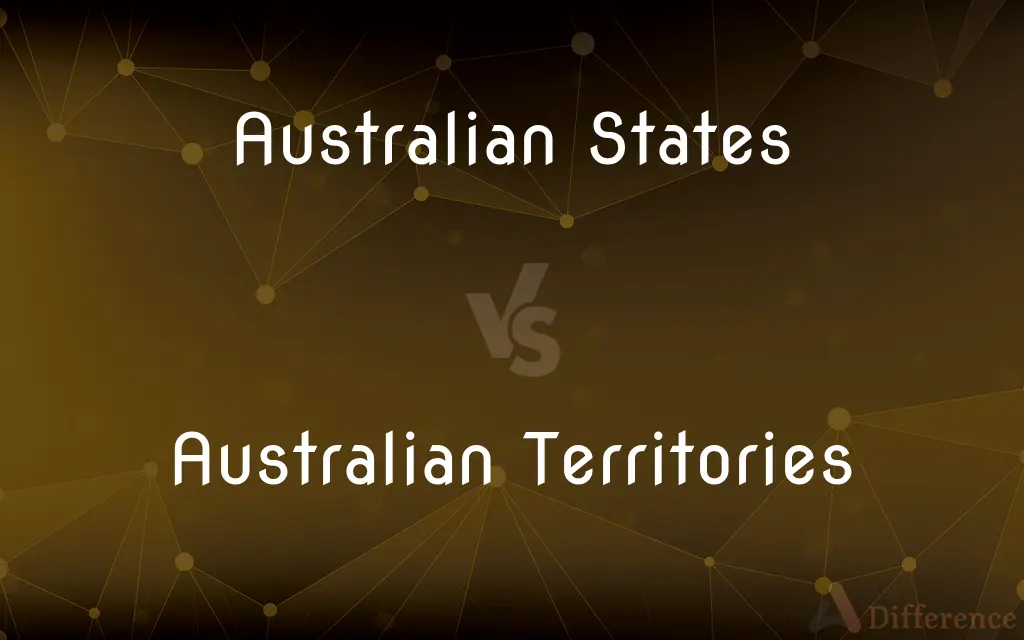Australian States vs. Australian Territories — What's the Difference?
Edited by Tayyaba Rehman — By Fiza Rafique — Published on November 24, 2024
Australian states have their own governments with significant autonomy from the federal government, whereas territories are generally more directly governed by the federal government, with varying degrees of self-governance.

Difference Between Australian States and Australian Territories
Table of Contents
ADVERTISEMENT
Key Differences
Australia comprises six states and several territories, with the states being New South Wales, Queensland, South Australia, Tasmania, Victoria, and Western Australia. The states have their own constitutions and governments, exercising considerable autonomy in legislative powers, akin to federalism in other countries. On the other hand, Australian territories, notably the Northern Territory and the Australian Capital Territory, also have their own legislative bodies and can govern themselves in many areas.
The distinction between states and territories originates from Australia's constitution, which was written when only the states existed as separate colonies. The territories were acquired later and were not granted the same level of autonomy or recognition in the constitution. This historical context explains why territories have less power than states. For instance, while states have full control over their judicial systems, territories' legislation can be subject to federal review and alteration.
Financially, states have broader abilities to raise their revenues through taxes and have more established economies. Territories, conversely, might rely more heavily on federal government grants and funding to support their services and infrastructure projects. This dependency shapes the fiscal dynamics between the territories and the federal government, often leading to closer financial oversight and involvement by the federal government in territory affairs.
In terms of representation, both states and territories are represented in the Australian Parliament. However, the Senate representation is fixed at twelve senators for each state, regardless of population, ensuring equal state representation in federal decisions. Territories are underrepresented in comparison, with the Northern Territory and the Australian Capital Territory each having only two senators. This arrangement underscores the states' stronger position in the federal structure.
Despite these differences, territories have been granted increasing self-governance over the years. The Northern Territory and the Australian Capital Territory, for example, have their own legislative assemblies that enact laws on many issues similar to those of state parliaments. This evolution reflects a gradual blurring of the lines between states and territories in practical governance, even though significant constitutional differences remain.
ADVERTISEMENT
Comparison Chart
Autonomy
High autonomy; manage most affairs independently
Limited autonomy; federal government can override laws
Constitutional Basis
Established by the constitution as independent entities
Not originally recognized by the constitution; governed by federal law
Legislative Power
Own parliaments with significant legislative powers
Legislative assemblies with powers that can be limited by the federal government
Judicial System
Full control over their judicial systems
Subject to federal judicial review
Financial Independence
Broader ability to raise revenue through taxes
More dependent on federal funding
Federal Representation
Equal representation in the Senate (12 senators each)
Lesser representation in the Senate
Formation
Original colonies with self-governance
Formed by federal law or administrative action
Self-Governance
Complete self-governance
Varies; from significant self-governance to direct federal control
Dependency
Less dependent on the federal government
More dependent on the federal government for funding and support
Legal Override
State laws cannot be directly overridden by federal laws without constitutional support
Federal government can override territory laws
Compare with Definitions
Australian States
Original colonies that formed the basis of Australia.
The Australian states were originally separate colonies before federation in 1901.
Australian Territories
More reliant on federal funding compared to states.
The Australian Capital Territory receives significant funding from the federal government.
Australian States
Autonomous entities with their own governments and parliaments.
Victoria, an Australian state, has its own parliament and manages services like education and health.
Australian Territories
Have gained more self-governance over time.
The Northern Territory has its own legislative assembly that makes laws for local matters.
Australian States
Enjoy financial independence with the ability to levy taxes.
New South Wales generates revenue through state taxes on property and services.
Australian Territories
Dependent on federal legislation for their creation and powers.
The Australian Capital Territory was established by federal law.
Australian States
Represented equally in the Australian Senate.
Each Australian state, regardless of size, elects 12 senators to the federal parliament.
Australian Territories
Governed with varying degrees of federal oversight.
The Northern Territory governs itself in many areas but remains under federal oversight.
Australian States
Have significant legislative powers under the constitution.
Queensland state parliament passed unique environmental legislation.
Australian Territories
Underrepresented in the Senate.
Territories like the Northern Territory have only two senators, compared to twelve for each state.
Common Curiosities
Can the federal government override laws in Australian states?
While the federal government can pass laws on certain matters that apply to states, it cannot directly override state laws without constitutional or legal basis.
How does the representation in the Senate differ between states and territories?
States have equal representation with twelve senators each, while territories have significantly fewer senators, affecting their influence in federal decisions.
Are there any territories in Australia aiming to become states?
The Northern Territory has expressed interest in becoming a state to gain equal representation and autonomy, but this requires constitutional change.
How do territories gain more autonomy?
Territories can gain more autonomy through federal legislation that grants them additional powers or through negotiations with the federal government.
Can territory laws contradict federal laws?
Territory laws must comply with federal laws; federal laws override territory laws in case of conflict.
What mechanisms exist for resolving disputes between territories and the federal government?
Disputes can be resolved through negotiation, legislative changes at the federal level, or through the courts.
What is the role of the Governor-General in territories?
The Governor-General represents the Queen and the federal government in territories, playing a role in assenting to laws and overseeing federal interests.
What is the impact of federal control on territory policies?
Federal control can ensure uniformity in certain policies across Australia, but it may also limit territories' ability to tailor policies to local needs.
How do territories contribute to the Australian political landscape?
Territories contribute by providing unique perspectives on governance and policy, often leading to innovative approaches to local and national issues.
Why do territories have less power than states in Australia?
Territories have less power because they were not part of the original federation of colonies and are not fully recognized by the constitution.
How are taxes managed in territories compared to states?
Territories may have limited taxing powers and rely more on federal funding, whereas states have broader powers to levy taxes.
What historical events led to the current status of territories?
The acquisition of territories, changes in governance policies, and constitutional developments have shaped the current status of Australian territories.
Do territories have their own constitutions like states?
No, territories do not have their own constitutions. Their powers and governance structures are defined by federal legislation.
How does the public view the distinction between states and territories?
Public views vary, with some advocating for greater autonomy for territories and others emphasizing the importance of maintaining a strong federal system.
How does federal funding impact territory development?
Federal funding is crucial for infrastructure, healthcare, education, and other services in territories, often shaping their development priorities.
Share Your Discovery

Previous Comparison
Red Light vs. Blue Light
Next Comparison
Organizational Learning vs. Learning OrganizationAuthor Spotlight
Written by
Fiza RafiqueFiza Rafique is a skilled content writer at AskDifference.com, where she meticulously refines and enhances written pieces. Drawing from her vast editorial expertise, Fiza ensures clarity, accuracy, and precision in every article. Passionate about language, she continually seeks to elevate the quality of content for readers worldwide.
Edited by
Tayyaba RehmanTayyaba Rehman is a distinguished writer, currently serving as a primary contributor to askdifference.com. As a researcher in semantics and etymology, Tayyaba's passion for the complexity of languages and their distinctions has found a perfect home on the platform. Tayyaba delves into the intricacies of language, distinguishing between commonly confused words and phrases, thereby providing clarity for readers worldwide.















































